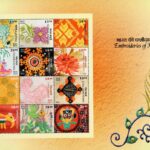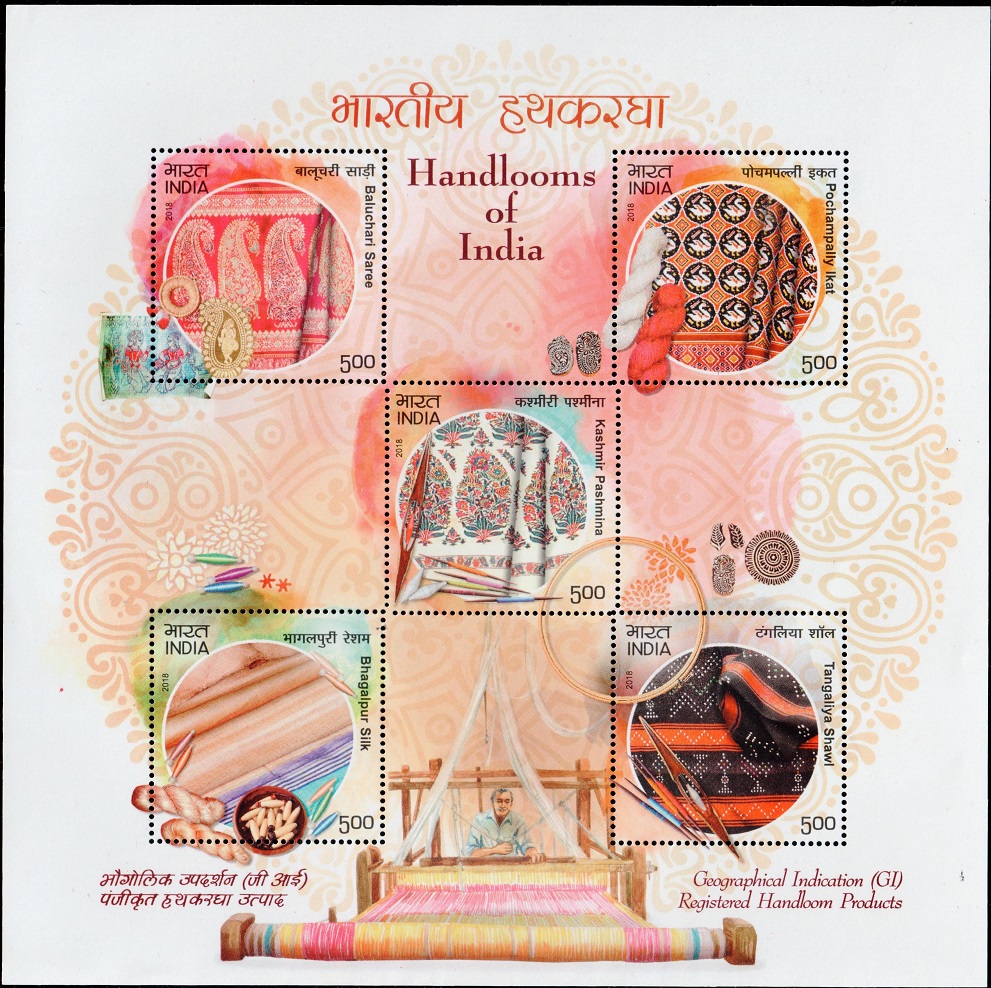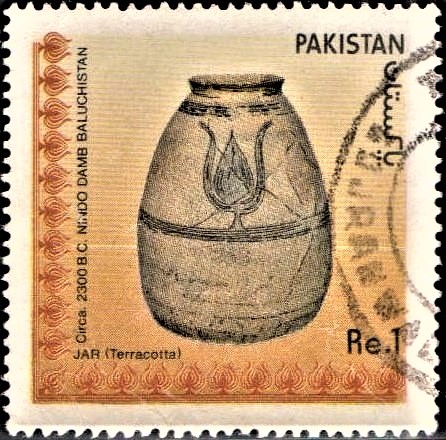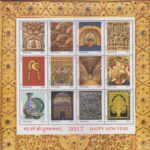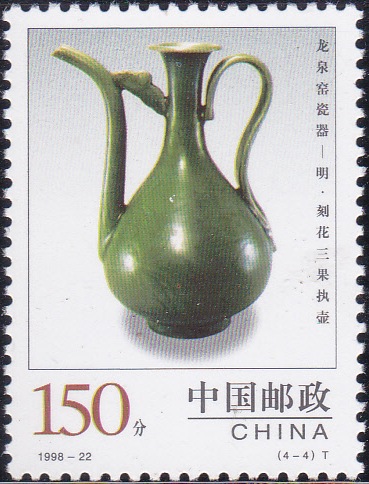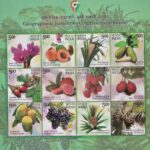
Handicrafts of India 2018
Complete set of 5 nos. of commemorative postage stamps on the Geographical Indication (GI) Registered Handicraft Products : Blue Pottery of Jaipur, Karnataka Bronzeware, Kutch Embroidery, Maddalam of Palakkad and Sikki Grass Products of Bihar :
 Issued by India
Issued by India
Issued on Dec 31, 2018
Issued for : Department of Posts is pleased to issue a set of five Commemorative Postage Stamps on Geographical Indication (GI) Registered Handicraft Products.
Credits :
Stamps/Miniature Sheet/FDC/Brochure/Cancellation Cachet : Shri Kamleshwar Singh
Type : First Day Cover
Colour : Multi Colour
Denomination : 500 Paise (5)
Stamps Printed : 606000 each
Miniature Sheets Printed : 110750
Printing Process : Wet Offset
Printer : Security Printing Press, Hyderabad
About :
- A Geographical Indication (GI) is a name or sign used on certain products which corresponds to a specific geographical location or origin (e.g. a town, region, or country). India, as a member of the World Trade Organization (WTO), enacted the Geographical Indication of Goods (Registration and Protection) Act, 1999 with effect from 15 September 2003. The GI tag ensures that none other than those registered as authorised users (or at least those residing inside the geographic territory) are allowed to use the popular product name. Darjeeling tea became the first GI tagged product in India, in 2004-05, since then by May 2017, 295 other GI tagged products have been added to the list.
- Department of Posts is releasing a set of Commemorative Postage Stamps on GI Registered Handicraft Products as follows:
- GI Registered Handicraft Products:
- Blue Pottery of Jaipur: The art of blue pottery came to Jaipur from Persia and Afghanistan in the 14th century. The use of blue glaze on pottery made from Multani Mitti, or Fuller’s earth, is an imported technique, first developed by enterprising Mongol artisans who combined Chinese glazing technology with Persian decorative arts. Man Singh-I was the first to bring the art of blue and white to Jaipur subsequent to his interactions with the Mughals through his campaign in Afghanistan. Blue Pottery has unique features as the pottery is completely hand painted, does not develop cracks and is impervious, hygienic and suitable for daily use.
- Karnataka Bronzeware: In Karnataka, bronze casting flourished under Chalukyas, Rastrakutas, Hoysalas and the Vijayanagara period. The Hoysala king Vishnuvardhana under Vaishnava faith, erected many magnificent temples with exquisite metal icons. Bangalore, the capital city of Karnataka, is the chief craft cluster for Bronze Casting. Traditional Indian bronzeware has worldwide reputation in overseas market because of its superior workmanship and modest price. Indian bronzes find place in museums at Boston, New York, Paris, London, Berlin etc. The artisans engaged in making bronze icons known as ‘Stapathies‘ are bound by faith, tradition and religion for making bronze icons and should be well versed in ‘dhynanaslokas‘, which gives the physical attributes to the deity. The traditional crafts persons were an unbroken chain of evolution passing from teacher to the disciple and father to son.
- Kutch Embroidery: The Kutch Embroidery originated in Kutch–Gujarat with the arrival of different communities that migrated from countries like Iran, Iraq, Greece, Germany, Afghanistan during 16th & 17th centuries. Kutch embroidery is basically practised by women. Kutch work is unique in the sense that a net is woven on a cloth using thread. The net is then filled in using the same thread by intricate interlocking stitches. The patterns are usually built around geometric shapes. Designs of Kutch Embroidery are inspired by legend and everyday life. Each individual community expresses its own identity through a sense of aesthetics, colour, layout and motif preferences that evolved out of specific aspects of their history, including migration patterns and contact with surrounding people. However, the different adornment traditions are unified by regional styles and by motifs that bridge cultures: peacocks, parrots, temples, flowers, camels and elephants, human figures in dancing poses, dancing peacocks. It’s a tradition which is handed down from generation to generation (mothers to daughters), thereby skilling and empowering them.
- Maddalam of Palakkad: Maddalam is considered a divine instrument on account of its inclusion as a major accompaniment in the dance of Shiva. Maddalam dates back to 13th century. The sound produced by Maddalam is considered to be Pranavam or the sound of ‘Om‘ or ‘Aum’. It is very similar to the mridangam. The maddalam is the classical drum of South India and is used as an accompaniment for vocal, instrumental and dance performances. Panchavadyam which is regarded as one of the most sophisticated art forms of Kerala is an ensemble of five percussion instruments viz. drums timila, maddalam, edaykka, the cymbals ilathalam and the kombu horn. Cylindrical in shape, maddalam till today is chiselled out of a single piece of jack wood. There are two varieties of maddalam- Suddha maddalam and Toppi maddalam. The former is tied around the waist of the drummer with a cloth while the latter is a smaller version suspended from the neck.
- Sikki Grass Products of Bihar: Sikki, the golden grass of Bihar, is found growing in the wet and marshy area of Madhubani district. Sikki work is practised by women in the region of Bihar. There is growing demand for Sikki Grass work not only for outstanding beauty but also for its cultural value. At one point of time, a very large part of the population in North Bihar (i.e. pockets in Darbhanga, Madhubani and Sitamarhi districts of Bihar) was engaged in this craft. The sikki is characterized by its wonderful golden hue, is also coloured into myriad shades to make the products more attractive. The products made from sikki grass are as utilitarian as they are uniquely ornamental. They include containers to store grain, rice, and lentils; boxes to keep clothes and jewellery, baskets to store sweets and masalas (spices) etc.
- Text : Based on information received from Ministry of Textiles.


